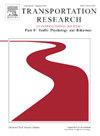汽车跟随行为的实证分析:驾驶员人口统计特征、主要车辆类型和限速对驾驶员行为和安全的影响
IF 4.4
2区 工程技术
Q1 PSYCHOLOGY, APPLIED
Transportation Research Part F-Traffic Psychology and Behaviour
Pub Date : 2024-11-29
DOI:10.1016/j.trf.2024.11.022
引用次数: 0
摘要
跟车行为是最基本、最常见的驾驶行为,对道路安全和交通效率至关重要。追尾行为对交通流动力学的影响很大,驾驶员相关因素是追尾事故的主要原因。尽管对汽车跟随行为进行了广泛的研究,但在理解这种行为如何在不同文化的驾驶员群体和异质驾驶条件下表现出来方面仍然存在差距。本研究的目的是实证研究个人特征、领先车辆类型、领先车辆的限速和减速率对汽车跟随行为的影响。为此,在驾驶模拟器环境中,在50 km/h和80 km/h两种不同限速条件下,以摩托车、轿车、SUV和卡车为领先车辆的8种不同场景下,对61名参与者的跟车行为进行了调查。结果表明,随着性别、年龄、驾驶经验、教育程度、领先车辆类型以及限速和减速率的不同,跟随车辆的行为存在相当大的差异。研究发现,在限速较低的情况下,两轮车(摩托车)作为领先车辆时,发生追尾事故的风险更高。此外,女性被认为比男性有更高的撞车风险。总而言之,这项研究提供了宝贵的见解,可用于加强道路安全,例如为高危群体量身定制有针对性的培训材料,并为政策决策提供信息。将这些见解纳入模型校准可以导致更准确和真实的模拟,以捕捉真实驾驶场景的复杂性。本文章由计算机程序翻译,如有差异,请以英文原文为准。
Empirical analysis of car-following behavior: Impacts of driver demographics, leading vehicle types, and speed limits on driver behavior and safety
Car-following behavior is the most fundamental and common driving behavior and is crucial for road safety and traffic efficiency. Traffic flow dynamics are greatly affected by this behavior, and driver-related factors in car-following behavior have been identified as a key cause of rear-end crashes. Despite extensive research on car-following behavior, a gap remains in understanding how this behavior manifests itself in culturally diverse driver populations and heterogeneous driving conditions. The aim of this study was to empirically investigate the effects of individual characteristics, leading vehicle types, posted speed limits and deceleration rates of the leading vehicle on car-following behavior. To this end, the car-following behavior of 61 participants was investigated in eight different scenarios involving a motorbike, sedan, SUV, and truck as the leading vehicle under two different speed limits, i.e., 50 km/h and 80 km/h in a driving simulator environment. The results showed that considerable variations in car-following behaviors exist depending on gender, age, driving experience, educational levels, and the type of leading vehicle, as well as speed limits and deceleration rates. The risk of rear-end crash was found to be higher at the lower speed limit and with a two-wheeler (motorbike) as the leading vehicle. Additionally, females were identified as a having higher crash risk than males. In summary, this study provides valuable insights that could be applied to enhance road safety, such as tailoring targeted training materials for high-risk groups and informing policy decisions. Incorporating these insights into model calibration can lead to more accurate and realistic simulations that capture the complexities of real-world driving scenarios.
求助全文
通过发布文献求助,成功后即可免费获取论文全文。
去求助
来源期刊
CiteScore
7.60
自引率
14.60%
发文量
239
审稿时长
71 days
期刊介绍:
Transportation Research Part F: Traffic Psychology and Behaviour focuses on the behavioural and psychological aspects of traffic and transport. The aim of the journal is to enhance theory development, improve the quality of empirical studies and to stimulate the application of research findings in practice. TRF provides a focus and a means of communication for the considerable amount of research activities that are now being carried out in this field. The journal provides a forum for transportation researchers, psychologists, ergonomists, engineers and policy-makers with an interest in traffic and transport psychology.

 求助内容:
求助内容: 应助结果提醒方式:
应助结果提醒方式:


